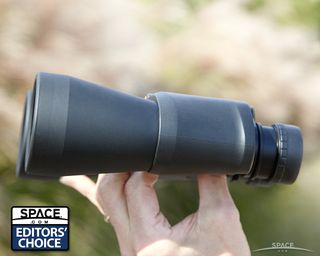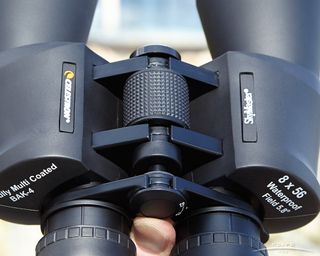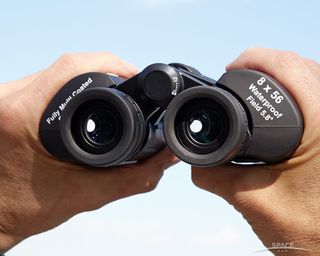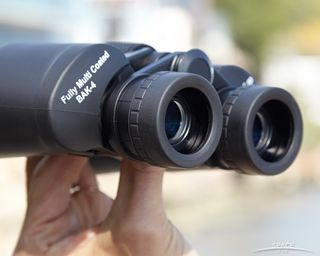Celestron SkyMaster 8x56 Binoculars: Full Review

Here's the situation: You only have, say, $250 to spend on binoculars. You want to sky-watch, but you also want to go birding, boating, hiking and you want to see the players at the game up close, even though your seats are in nosebleed country. You need an astronomy-capable medium size binocular. We think we've found a solution for you: Celestron's SkyMaster 8x56, our Editors' Choice for the best medium-size binoculars for astronomy.
Weighing only 38 ounces, you can carry these for hours during your busy outdoor day. At night, lie back in an outdoor recliner and you can hand-hold them for a good long while. The wide rubber bumpers on the oculars' lens-guards are comfortable enough to rest on your cheekbones and brow (eye "orbits").
Buyer's Guide: How to Choose Binoculars for Stargazing
Below: See our Hands-On Video Tour of Celestron's SkyMaster 8x56:
But for the most soulful starlight absorption you'll want to spend $16 for a tripod adapter and perhaps up to $100 for a tripod with multi-axis head. Of course, you can use your existing camera tripod. Just make sure it doesn’t wiggle in the wind; dancing stars will give you a headache.
These SkyMasters are sealed and wrapped in rubber. They won't slip in your hands, or slide around a moderately pitching boat deck. They were "nitrogen purged" at the factory in China, which means they've been injected with nitrogen gas, "chasing out" any water vapor before sealing the optical cans.
Best Astronomy Binoculars (Editors' Choice)
Get the Space.com Newsletter
Breaking space news, the latest updates on rocket launches, skywatching events and more!

Taken together, these factors effectively "waterproof" the binoculars' optics (though the adjustable ocular ring and the center focus wheel could rust or corrode in time). They also make the optics resistant to condensation. You can still make them fog up by, say, taking them from your dry, air-conditioned den straight out into the hot muggy late-summer night. [And when you go back in again, after an hour or so in moist air, it'd be a good idea to leave the lens caps off until your 8x56s are completely dry.] Or save you stargazing for the night after the cold front passes. As every skywatcher soon learns, the crispest stars are seen on the coldest night.
Eyeglass wearers will be thankful for the relatively long 18mm of eye relief. [Eye relief is the distance from the eyepiece lens' surface to the last spot a full-width image can be seen.] You can probably get your glasses cozily up against the soft twist-up style lens guards to seal out stray light, which can distract you from reading those messages the stars are sending you.

The generous 7-millimeter exit pupil is wide enough for your mind to fall into. ["Exit pupil" is the area of virtual image at the binoculars' "focus point," the circle you look into.] We've notice relatively larger exit pupil diameters on small and medium Celestrons. The perfectly round disc of that exit pupil tells you something encouraging about the quality of the BaK-4 glass Porro prisms within. A lesser binocular might show you some angular fall-off, especially towards the top of the exit pupil.

The 8x56s will focus no closer than about 25 feet (7.6 meters). That's enough for most terrestrial applications. If you’re closer to an animal than that, you probably don't need it magnified unless it's tiny. Similarly, any sports activity taking place that close to you is de-facto a naked-eye proposition. The stars, of course are very, very far away. At 5.8 degrees, the Celestron's field of view is decidedly "medium" compared to, for example, the Vixen Ascot 10x50's 8.5 degrees. But it’s wide enough to get a satisfying sense of perspective on objects in the sky.
Frankly, "Medium Astronomy Binoculars" was a tough category for us to judge. Both the Celestron SkyMaster 8x56 and the Oberwerk Ultra 15x70 could easily have garnered our Editors' Choice. We picked the SkyMasters for a few reasons:
The Celestron SkyMaster 8x56 binoculars weigh less than half the Oberwerk Ultra 15x70, a big difference if you're holding the binoculars by hand all night.
The SkyMasters are also less than half the price of the Ultras. But if you can afford the Oberwerk Ultra, it is unquestionably worth the cost. [There is a big difference in magnification, so make sure you really want 15x and the narrower field of view that goes along with it.]
It is also worth mentioning the Celestron Echelon 10x70 binoculars; it is an extremely fine quality binocular in the Medium range. But, at a "street-price" of at $750, the Echelon was out of bounds for us to consider, this time around, as were similarly excellent instruments from Steiner.
We would have liked to see a better strap on these binoculars. No, it doesn't matter for astronomy on a tripod. But you will want to take this excellent, rugged hobby-enhancer out to play in daylight. Consider investing in a quality camera strap that has a little elastic shock absorption to it.
Specifications
- 8x Magnification: Objects appear roughly eight times larger than your eye alone would see them
- 56 mm Objective Diameter: The large lenses on the front measure 56 millimeters across.
- 35 ounce weight: These binoculars weigh 2 lbs 3 oz; much more easily handheld than our Runner-Up.
- 5.8-degree Field of View: Wider is better, but more important for things that move (birds, kids playing sports) than for astronomy.
- 303 Feet Aspect Width at 1,000 yards: Another way to visualize Field of View: Wider gives you more of a "spacewalk" experience.
- 7mm Exit Pupil: Bigger is better: This one is wide enough for all ages to "fall into." It's nearly perfect for astronomy.
- $210 Street Price: You should expect to pay about $210 (+ shipping) after some comparative shopping.
To check out some other binoculars, or learn how to evaluate and compare binoculars for yourself, go ahead and choose from the links below:
- Best Astronomy Binoculars (Editors' Choice)
- How to Choose Binoculars for Astronomy and Skywatching
- Best Telescopes for the Money - 2019 Reviews and Guide
Follow the author @DavidSkyBrody. Follow us on Twitter @Spacedotcom and on Facebook.

Join our Space Forums to keep talking space on the latest missions, night sky and more! And if you have a news tip, correction or comment, let us know at: community@space.com.
Dave Brody has been a writer and Executive Producer at SPACE.com since January 2000. He created and hosted space science video for Starry Night astronomy software, Orion Telescopes and SPACE.com TV. A career space documentarian and journalist, Brody was the Supervising Producer of the long running Inside Space news magazine television program on SYFY. Follow Dave on Twitter @DavidSkyBrody.

